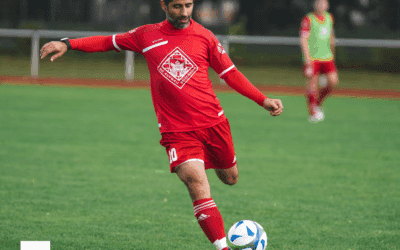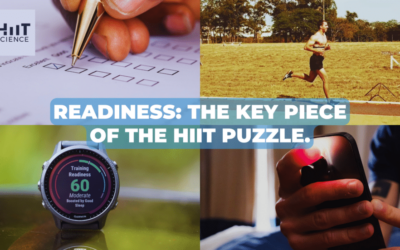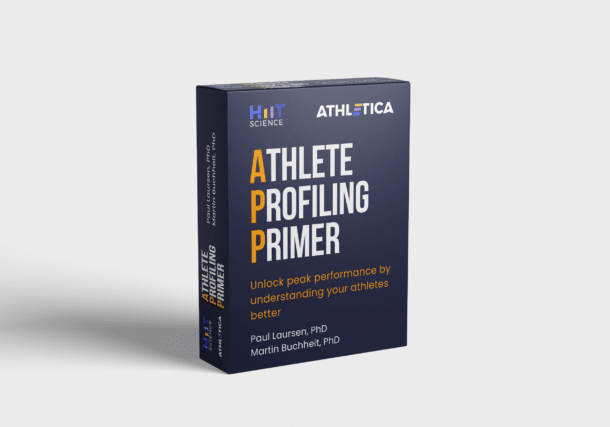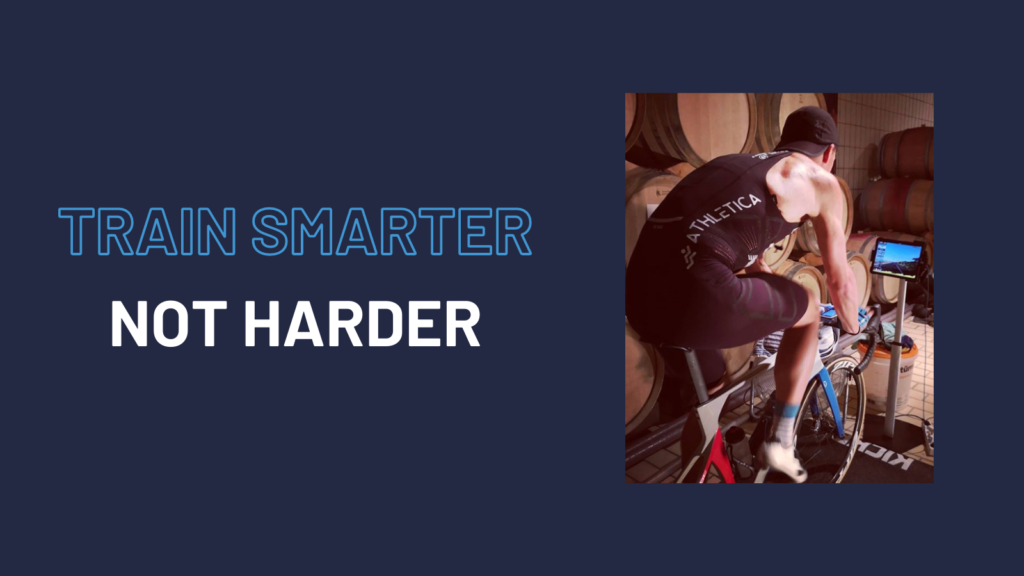 I’ve previously written about my “semi-pro” days as a young triathlete in the late 80s and early 90s, and love reflecting on the fitness that was gifted to me in those days (I miss it). To show my age, this was in fact before the internet was part of daily life. For the latest happenings in our sport we went to Triathlete Magazine, which I read religiously each month, cover-to-cover. One of the features that inspired me then was the story of an up-and-coming triathlete, Pauli Kiuru of Finland, and how he used a heart rate monitor to control his pacing in long distance races. Here, he claimed to have certain heart rate cut-offs he would adhere to in order to preserve an energetic balance that theoretically would optimize his overall performance time in the Ironman. Pauli and his coach were using technology to gain insight into his physiological underpinnings in an attempt to learn and benefit his performance. At the time, it was revolutionary. Performance was no longer just being done by feel. I was inspired. The observation lead to my Masters research project and ultimately the path I continue down to this day with HIIT Science and Athletica. Admittedly, I still have an obsession with how we can integrate exercise science into coaching using technology to maximize our health and performance.
I’ve previously written about my “semi-pro” days as a young triathlete in the late 80s and early 90s, and love reflecting on the fitness that was gifted to me in those days (I miss it). To show my age, this was in fact before the internet was part of daily life. For the latest happenings in our sport we went to Triathlete Magazine, which I read religiously each month, cover-to-cover. One of the features that inspired me then was the story of an up-and-coming triathlete, Pauli Kiuru of Finland, and how he used a heart rate monitor to control his pacing in long distance races. Here, he claimed to have certain heart rate cut-offs he would adhere to in order to preserve an energetic balance that theoretically would optimize his overall performance time in the Ironman. Pauli and his coach were using technology to gain insight into his physiological underpinnings in an attempt to learn and benefit his performance. At the time, it was revolutionary. Performance was no longer just being done by feel. I was inspired. The observation lead to my Masters research project and ultimately the path I continue down to this day with HIIT Science and Athletica. Admittedly, I still have an obsession with how we can integrate exercise science into coaching using technology to maximize our health and performance.
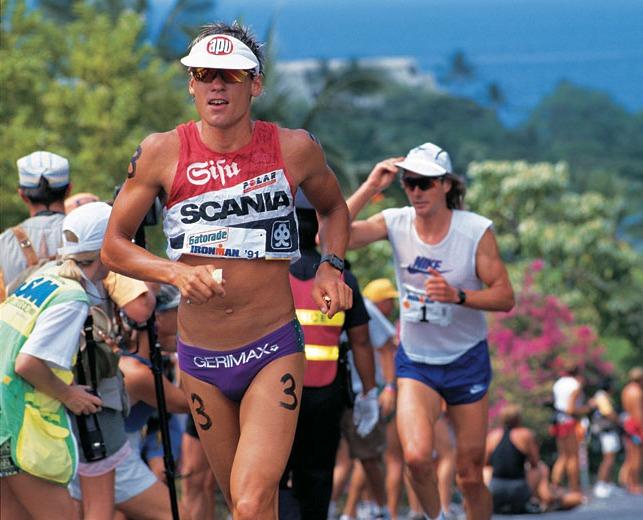
Pauli Kiuru, from Finland, leading Mark Allen at the 1991 Ironman in Kona. Pauli’s portable Polar heart rate (HR) monitor prototype can be seen on his wrist capturing HR during the race.
Athletica — the technology arm of HIIT Science — is a tool that athletes and coaches can use to leverage the HIIT Science principles in practice.

Figure 1. Athletica aims to leverage technology using first principle exercise science concepts into ideal coaching and training prescriptions.
Nurture your nature
One of my favourite illustrations from the sport sciences is shown below in Figure 2. Here, Ross Tucker and Malcolm Collins show simply that athlete preparation (nurture) actually matters. The figure shows six representative athletes (A-F) of varying levels of innate (genetic) performance potential for a given sport. As most of us appreciate, innate talent (nature) is the critical factor. We know athletes that can do just about anything in a given sport despite what may appear to be sub-par preparation (if only they would do xyz). They rock up, and appear so blessed with skill and physiology that they excel no matter what they’ve done prior. Nearly any recipe seems to work. But when we dig a bit deeper, and our pool of talent is raised in a sport, we discover that indeed, how we prepare actually matters. Things like the training stress made specific to an individual’s physiology, just the right amount of stress, recovery, nutrition, psychology, taper, etc — it all begins to matter. So much in fact that when an athlete with marginally less innate ability (nature) than her competitor toes the line for a given sport, she can win out over her more talented counterpart due to better preparation (nurture).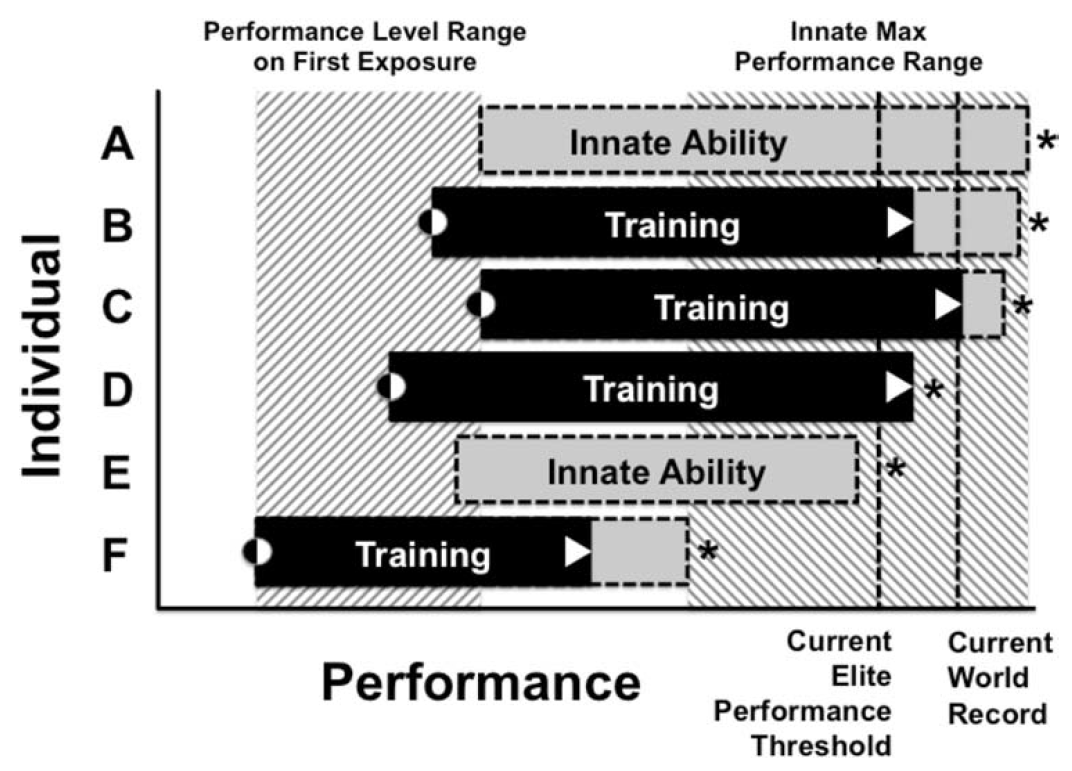
Figure 2. A theoretical illustration of the combined effects of nurture (black rectangles) and nature (grey rectangles) on the actual and potential sporting performance level of six injury free, healthy subelite and elite individuals (A to F). In this model, training is defined as the process by which genetic potential is realised. Two individuals (A and E) are not athletes or have not participated in the sport, while the remaining four individuals (B, C, D and F) actively train and participate in the sport. The initial performance level on first exposure to the sport, and the current performance of the four athletes are indicated by black-white circles and white triangles, respectively. The asterisk indicates the maximum performance threshold of all individuals. There are interindividual differences between the actual (B, C, D and F) and potential (A and E) starting performances of the individuals, which are determined by both nature and nurture. There are also interindividual differences between the maximum performance thresholds of all six individuals, which are determined genetically. There is not necessarily a tight positive correlation between the athlete’s starting and maximum threshold performances. Dashed lines indicate the hypothetical elite performance threshold and current world record. Although athlete D would be considered elite, he or she has reached a maximum performance threshold through training, and further improvements are not possible. Athlete C is the current world record holder but retains the capacity for improvement (grey box) and the ability to further improve the world record. However elite athlete B, whose current performance level is lower than athlete C, also has the potential to break the current world record. Elite athlete B is also potentially a better athlete the current world record holder (athlete C). [Direct quote from Figure 2 in Tucker & Collins (2012)].
Applying sports science for all
Herein lies the essence of what we are aiming to do with Athletica. We’re trying to create a tool that helps answer the question posed in Figure 3 — what training should I do today to hit my physiological target? And also why?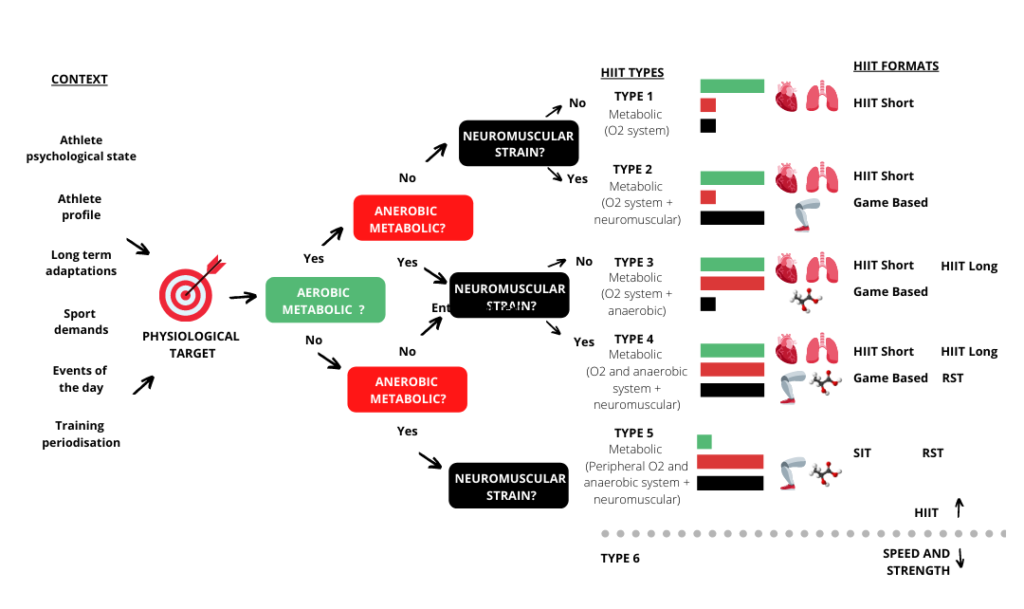
Figure 3. The key HIIT Science figure.
As humans, we learn by feeling and doing
Some of the most consistent feedback that’s come through our beta testers is just how much they’ve enjoyed learning the HIIT Science principles, by going through the testing, training, term index, and detailed descriptions of the session purpose — why the session should be performed as recommended. Thus, as an Athletica athlete (and soon coach), you have the added bonus of learning by feeling and doing.The team
Our diverse team of selfless Outside the box Type 3 thinkers, who have always been clear on their why, have worked countless free hours to bring Athletica to life. I am so proud of this group and what we have realized as a team. It hasn’t been easy, but we’ve continued venturing forward, and Athletica now officially has a life.
The team behind Athletica.
Athletica’s roadmap
Many have been asking — What’s the short and moderate-term plan for Athletica? In the coming months, we’ll be focused on a number of new features that leverage the fields of mathematics and sport science to apply the HIIT Science principles using modern wearables. Expect a new blog post in coming months from us on specifics. In the short term, we’ll be focussed on enabling these features in the sports of triathlon, running and cycling, as well as providing a system that coaches can use for their athletes, and which researchers can use to conduct their studies. Moderate to long term, we’ll be looking to apply this intelligence to more endurance sports, before considering how we can leverage the Athletica principles for team sports. Figure 4, from HIIT Science, shows the key chapters that Athletica is working on implementing.
Figure 4. The key chapters from HIIT Science that are being implemented in Athletica for athletes and coaches.
The future is now
Technology and its potential is no longer reserved for our imaginations and the movies. It’s well and truly happening all around us. I was privileged to be an examiner for the doctoral thesis of Guro Strøm Solli, who offered an exceptional trial lecture on the state of the industry that can be viewed here.We’re embracing the challenge, and we are fascinated by what we can learn. It shows us something new every day. As our backend lead, Dr Andrea Zignoli likes to say, it is indeed, the greatest show on earth. We hope you’ll join us!The trial lecture of Guro Strøm Solli ”Advances in Artificial Intelligence and Real-Time Feedback for Exercise Prescription” is available here: https://t.co/VKD8Ew6iwA
— Øyvind Sandbakk (@OyvindSandbakk) November 12, 2020


